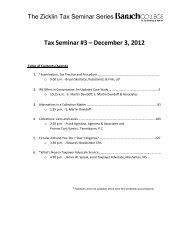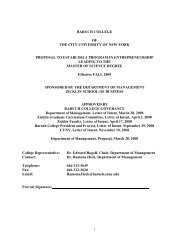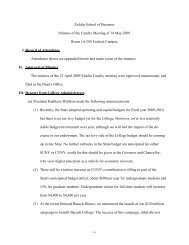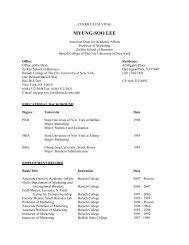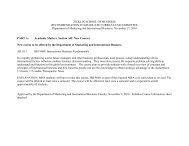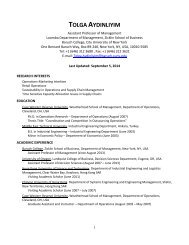Current Financial Reporting Trends
Current Financial Reporting Trends: - Zicklin School of Business
Current Financial Reporting Trends: - Zicklin School of Business
- No tags were found...
You also want an ePaper? Increase the reach of your titles
YUMPU automatically turns print PDFs into web optimized ePapers that Google loves.
• Describe the accounting for interest rate swaps that were terminated prior to the<br />
expiration date, in accordance with paragraphs 32 and 33 of SFAS 133.<br />
• Tell us and revise the footnote or MD&A, as appropriate to discuss how the derivative<br />
instruments qualified for hedge accounting under SFAS 133 and how your accounting<br />
policies comply with that standard, including the following:<br />
o The specific nature of the hedged assets and liabilities and if the hedge is a fair<br />
value or cash flow hedge.<br />
o Describe your formal documentation of the hedging relationships.<br />
o How you identify the hedge item or transaction and the hedge instrument.<br />
o Describe the quantitative measures of correlation you use to assess<br />
effectiveness of each hedge both at inception and on an ongoing basis.<br />
o Describe how you assess the ineffectiveness of the hedge.<br />
o<br />
o<br />
o<br />
o<br />
o<br />
Disclose when you perform these assessments.<br />
Disclose where you present the gains and losses relating to hedge<br />
ineffectiveness in the statements of income and explain why that presentation<br />
is appropriate.<br />
Describe the quantitative measures you use to assess effectiveness of each<br />
hedge both at inception and on an ongoing basis.<br />
Explain how often you assess and how often you back test and how these<br />
determinations have resulted in no hedge ineffectiveness for the periods<br />
presented.<br />
Describe and quantify the impact of your use of derivatives on interest income<br />
and expense.<br />
Comment #682 – Form 10-K; SIC: 2020 Dairy Products<br />
We note, on page 75, that you have recorded changes in the fair value of securities to accumulated<br />
other comprehensive income. We further note the following in your derivative commodity<br />
instruments policy on page 76, which appears to be inconsistent with your recording of changes in<br />
fair value of securities to accumulated other comprehensive income:<br />
* Changes in the fair values of futures contracts are recognized in earnings; and<br />
* Changes in the fair values of interest rate swaps designated and effective as fair value hedges<br />
are recorded in net earnings and are offset by corresponding changes in the fair value of the<br />
hedged debt.<br />
Please clarify how you account for your derivative financial instruments, provide the disclosures<br />
required by paragraphs 44 to 47 of SFAS 133, and describe the financial statement line items<br />
where derivative activities are recorded, to the extent applicable and material.<br />
Comment #570 – Form 10-K; SIC: 5047 Wholesale-Medical, Dental & Hospital Equipment &<br />
Supplies<br />
Please tell us how you are accounting for the embedded conversion feature present in your<br />
convertible debt. In particular, tell us whether you have bifurcated the embedded conversion<br />
feature from the host contract and accounted for it as a mark-to-market derivative liability under<br />
SFAS 133 and why or why not.<br />
In this regard, based on our understanding of the terms of the convertible debt, it would appear<br />
that the embedded conversion feature meets the three criteria in paragraph 12 of SFAS 133 for<br />
bifurcation from the host contract. If you disagree, please advise us in detail as to how you arrived<br />
at your conclusion.<br />
Moreover, once bifurcated from the host contract, it would appear that the embedded conversion<br />
option should be treated as a mark- to- market derivative liability pursuant to the guidance in SFAS<br />
133 regarding accounting for derivative instruments, unless the embedded conversion option<br />
qualifies for the paragraph 11(a) scope exception. If you believe the conversion option qualifies for<br />
the paragraph 11(a) scope exception, please tell us in detail how you arrived at this conclusion. In<br />
crafting your response, please note that this scope exception is a two step test, and both steps<br />
must be met to qualify.<br />
The first step is to determine whether the instrument is indexed to a company’s own stock. Since<br />
exercise of the conversion option in this case is contingent on certain events, please tell us<br />
16



